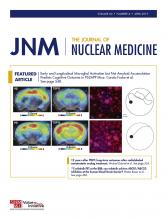REPLY: We thank Laffon and Marthan for their interest in our study (1). They discuss the influence of measurement uncertainty on the ability to detect changes in measurements.
We refer them to previous work by members of our group (2) that compared 18F-fluoride Ki measurement derived from 60-min dynamic PET acquisitions and a semipopulation input function approach, using the Hawkins model (3) and similar methods that allow k4 to be fitted as a free variable, in 20 women who underwent scanning at 0, 6, and 12 mo after stopping bisphosphonate therapy. The paper reported similar precision errors (% coefficient of variation) between all Ki methods and SUVmean (12.9%–14.8% and 10.1%, respectively). That study also indicated that Ki is likely to be a more reliable index of changes in bone turnover than SUV in studies in which the treatment alters the arterial input function.
In our current study, Ki is calculated from a single static scan at 60 min after injection (1). This is, in effect, measuring SUV, with all the benefits of good precision, and then converting this into a Ki measurement using plasma concentration data from venous blood samples taken more than 30 min after injection when venous and arterial blood are in equilibrium. The plasma measurements have excellent precision and accuracy as blood samples can be timed to a few seconds, the plasma samples are weighed to an accuracy of 1 mg, and the counting statistical errors in the γ-counter are about 1%. Although we add a fixed residual curve, it is important to note that approximately 75%–80% of the total area under the curve at 60 min comes from the single exponential. Also, if the bone treatment alters the input function, then it is the terminal exponential that will show the greatest change, not the residual function, which reflects the bolus peak and the early rapid mixing with soft tissue.
We therefore believe that precision errors for our method of measuring Ki and those for SUVs will be similar and that a 25% cutoff is a reasonable starting point to differentiate progressive disease from non–progressive disease for 18F-fluoride SUVmax, SUVmean, and Ki. We also believe that for treatment monitoring, Ki is a more reliable parameter to detect changes in bone turnover than SUVs, particularly when the therapy may affect the arterial input function.
Footnotes
Published online Mar. 8, 2019.
- © 2019 by the Society of Nuclear Medicine and Molecular Imaging.







